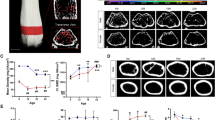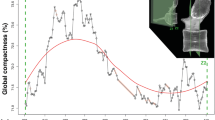Abstract
A non-destructive, three-dimensional technique for microstructural phenotypic characterisation of skeletal elements in genetically altered mice is presented. Preliminary data in bovine growth-hormone transgenic animals and control littermates are shown. The technique is based on microcomputed tomography (μCT) and digital postprocessing and allows for a differential quantitative analysis of the cortical and trabecular bone compartments in the axial and peripheral skeleton. The distal femora and the first lumbar vertebral bodies of six animals were CT scanned in the axial plane with an isotropic resolution of 20 µm. The periostal surface and the marrow spaces were segmented fully automatically, and the trabecular and cortical compartments were separated interactively. After 3-D reconstruction, various regions of interest (diaphyseal, metaphyseal and epiphyseal) were selected for the analysis. The femora and vertebrae of the transgenic animals showed obvious differences in size, shape, and trabecular arrangement compared with the control animals. The total bone mass was increased by a factor of two to three, but the trabecular bone was increased much more (up to 12 times) than the cortical bone. The transgenic animals showed an increased ratio of trabecular vs cortical bone (0.90 to 1.27 vs 0.14 to 0.36 in the femoral diaphysis) and an elevated trabecular bone volume fraction (49% to 73% vs 18% to 43% in the femoral metaphysis). The mean 3-D cortical thickness was similar in the normal and transgenic animals (values between 93 µm and 232 µm in the dia- and metaphyses), but the minimal cortical thickness was lower in the transgenic animals (22 to 31 µm vs 54 µm to 110 µm in the diaphysis). The technique presented is suitable for phenotypic characterisation of bone structure in genetically altered mice.
Similar content being viewed by others
Author information
Authors and Affiliations
Additional information
Accepted: 14 August 1998
Rights and permissions
About this article
Cite this article
Graichen, H., Lochmüller, EM., Wolf, E. et al. A non-destructive technique for 3-D microstructural phenotypic characterisation of bones in genetically altered mice: preliminary data in growth hormone transgenic animals and normal controls. Anat Embryol 199, 239–248 (1999). https://doi.org/10.1007/s004290050225
Issue Date:
DOI: https://doi.org/10.1007/s004290050225




